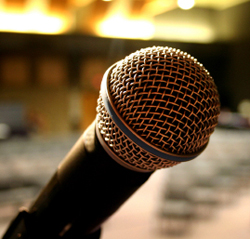One of the most degrading effects to a cardioid microphone’s frequency response is what’s called “proximity effect.” Proximity effect has to do with distance that a microphone is “worked”—and it can be a blessing or a curse.
When a sound source gets closer to the cardioid microphone the bass frequencies can be boosted up to as much as 18 dB in some cases! The closer the source, the “boomier” the bass.
Singers often use the proximity effect unconsciously, bringing the microphone closer to their lips for a warmer, more intimate tone. But in large scale sound systems. bass can be an enemy, making it harder to understand the words and having the levels change drastically as the performer unconsciously moves the microphone around in front of them.
It can also be a disaster when using a microphone with heavy proximity effect up close on an instrument, such as a piano, acoustic guitar or other “natural” sounding instrument. It can completely change the sound as though you turned the bass to “max” on the equalizer.
No amount of bass cut will fix it, for the frequency “center” of the proximity effect is not where in the frequency “center” of your bass EQ is. You simply need to experiment with a microphone to actually understand each model’s unique proximity effect behavior as it is not shown on a specification sheet.
With proximity effect, close is not always better. Sometimes it’s best to place the mic back 6 or even 12 inches from the source to avoid proximity effects, but then you risk picking up everything from the 20th row to the back stage wall!
The other damaging effect is that when using a microphone with your lips on it, the diaphragm will in many cases be overloaded, therefore the output will not be clean and articulate.
No amount of EQ will help as it all starts at the microphone and when it comes to the mixer full of low end distortion there is little hope. Remember: You can’t solve acoustic problems with electronic “fixes.”
This article is from the Heil Sound Microphone Primer. Check it out here.




















